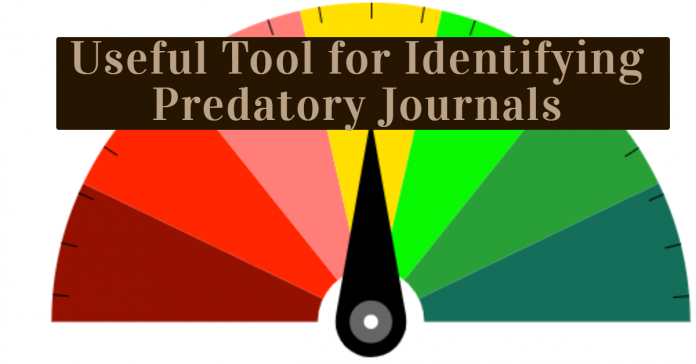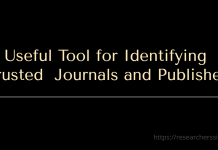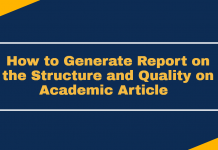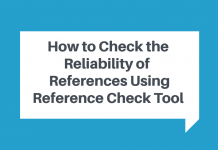In this blog post, I show you how to identify predatory journals using the useful tool “Compass to Publish”.
Compass to Publish evaluates open access journals based on a criteria-driven scale that quantifies their authenticity, especially in cases where Article Processing Charges (APCs) are required or concealed.
The journal’s authenticity is displayed on a dynamic scale from -20 (highly predatory) to +20 (no suspicion of deceptive practices). While a score can fall outside these limits, it’s capped at -20 or +20 for practical clarity and ease of use.”
Predatory journals and publishers are risking the academic integrity of published research.
The dubious journals abuse the author-pay open access model of scholarly publishing.
Here, I will walk you through the new unique tool “Compass to Publish” for identifying the predatory and fake journals.
The tool is developed by the ULiege Library, Belgium and has been released online mode.
It helps you determine the authenticity of open access journals requiring or hiding Article Processing Charges (APC).
Beyond that, the ground-breaking online tool allows you to identify the possible predatory journals.
The tool aims to help researchers to examine the degree of authenticity of open access journals.
Moreover, it permits scholarly community to better understand pseudo journals and publishers as well.
By answering a series of questions related to your journal, you can asses the authenticity.
This post will get you through how “Compass to Publish” works.
How Does Compass to Publish Tool Works
You can determine the degree of authenticity of a journal by answering the questions of the online test.
It is worth mentioning that the web app only evaluates the fraudulent nature of an open access journals.
But the tool does not evaluate the quality of a journals.
As per your answers, the web app generates different shade of color to check the degree of authenticity of your journal.
The greener area in shade of color means you can trust the journal.
In contrast, a red zone indicates a journal is risky.
How to Use The Useful Tool for Identifying the Predatory Journals
Let’s get started.
You have to provide answer enough queries for the assessment to be accurate.
To get started with the “Compass to Publish” tool, you follow the below steps:
Open the Compass to Publish Online Tool for Identifying Predatory Journals
First, navigate to the to web app to determine the degree of authenticity of your journal.
Once you open the online tool, you see following page:
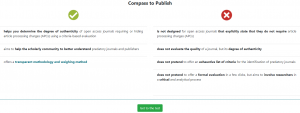
Entering Title and ISSN of Journal
Using the interface, you click on the “Get to the test” for identifying the possible predatory journals.
By clicking the button, you should see the queries like this:

Just now, you enter title and ISSN (or eISSN) both to detect your journal.
Keep in mind that you can end the online test at any time.
In order to obtain accurate diagnosis of your journal you should provide more answers.
Check Whether Your Journal DOAJ Indexed or Not
To check the degree of authenticity of your journal you provide information regarding the DOAJ indexing.
If the journal is open access, is it indexed in DOAJ ?

Once you answer, a progress bar will appear below. By clicking on “Next” you proceed for next questions.
Is the journal hosted on one of the Open Access Platform ?

All you need to do is you have to provide journal hosting related information.
Hosting Information :Open Access Platform
To make it simple they already specified the open access platforms:
Is the Publisher or the Journal a Member of OASPA ?
Here, you have to answer whether your journal or publisher is a member of OASPA or not.

Is the publisher or the journal a member of COPE ?
You answer the query-do they belong to the Committee on Publication Ethics ?

Is the journal published by a well-known publisher?
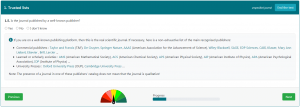
If you are on a well-known publishing platform then this is the real scientific journal.
Lists of Alleged Predatory Journals and Publishers
Is the journal included the DOAJ’s list of journals claiming to be indexed in Directory of Open Access Journals ?

Is the journal or publisher included in one of the lists on the website Stop Predatory Journals?
Is the journal or publisher included in one of the lists on the website Stop Predatory Journals?

Hijacked Journals
Predatory journals sometimes hijack the ISSN of an authentic journal to pass it off as their own.

Note: Make sure that the journal title you may get in the ISSN portal result strictly corresponds to the title that is mentioned on the journal’s website.

?

Is the journal you are testing a hijacked journal?
Fake or cloned journals seek to mislead authors by imitating the practices, names.
Does the publisher have a strangely similar name to another Publisher?
Some predatory publishers plays on a name resemblance with a well-known publishers to foster their own credibility.

Indexing and Metrics
Does the journal have the registered trademark “Impact Factor” (Clarivate Analytics TM)?
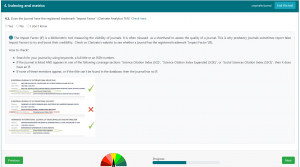
The Impact Factor (IF) measures the visibility of journals.
It is often misused as a shorthand to assess the quality of a journal.
In order to avoid such confusion, you check Clarivate’s site for registered trademark “Impact Factor”.
Is the journal really included in the various databases mentioned on its website?
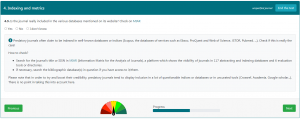
Pseudo journals often claim to be indexed in well-known databases or indices.
Checking Editorial Board and Peer Review Process
You have to be aware of the Editorial Board of the journal,. You should also check the peer review process.
In this step, you just answer the questions below:
- Are the editorial board members mentioned on the website?
- Does the possibly announced peer review policy seem surprisingly rapid for your discipline(s)?
After providing the information you proceed for the next section.
Content and Presentation Related Queries for Identifying the Predatory Journals
Here, you provide the information related to your journal’s content. It will take few seconds to answer:
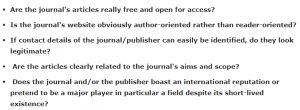
Communication Strategies
Do you repeatedly get unsolicited email (spam) from the journal/publisher?
Final Result:
Here is the result for unspecified journal as I did not answer any questions during the test.

So, make sure your academic research paper are in safe hands using the tool.
Final Thought
I hope this guide has provided valuable insights into spotting predatory journals and protecting the integrity of your research.
Ready to put this knowledge into action? Explore the tool now and make informed publishing choices!


